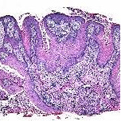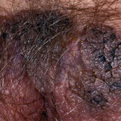Condyloma Acuminatum
General Information
More than 30 types (strains) of human papillomavirus (HPV) cause Condyloma Acuminatum (Genital Warts). The virus is spread by skin-to-skin contact during sexual activity; vaginal or anal penetration is not necessary to become infected. Patients that become infected with HPV will not have symptoms and will clear the infection on their own. Some of the virus types may cause cervical cancer. Most patients seek medical care when they notice lumps on the vulva, perianal area, or periclitoral area. These lesions are generally not painful, but they can be associated with pruritus. Bleeding can be observed if the lesions become confluent and are irritated by clothing. Genital wart treatments fall into three categories: prescription topical preparations that destroy wart tissue; surgical methods that remove wart tissue; and biological-based approaches that target the virus causing the underlying condition. Each treatment must be applied to individual warts.
Epidemiology
Approximately 10-15% of the 20 million people in the United States are infected with HPV
Etiology
Human Papilloma virus (HPV)
Pathogenesis
Lumps on the vulva, perianal area, or periclitoral area
Clinical
Soft, fleshy, flat warts on the skin, genitalia, perineum, and perianal regions
Histology
Shows evidence of hyperkeratosis, acanthosis, and parakeratosis. Koilocytosis, which is peri- nuclear cytoplasmic halos, is commonly observed in the superficial epithelial cells. Other microscopic findings include basilar hyperplasia with binucleated and multinucleated cells and enlarged parabasal cells with a foamy nuclear chromatin.
Bibliography
1 .”Condyloma Acuminatum” (Online) January 2008. http://www.emedicine.com/med/topic3293.htm (visited: March 15, 2008) 2. “Condyloma (Genital Warts)” (Online). http://www.healthscout.com/ency/68/405/main.html (visited: March 15, 2008)
Download PDF
![]() Condyloma Acuminatum
Condyloma Acuminatum


